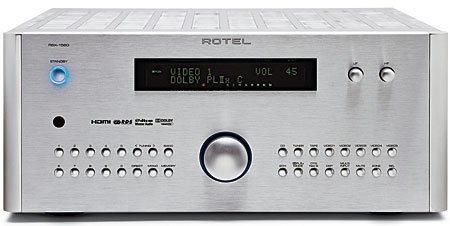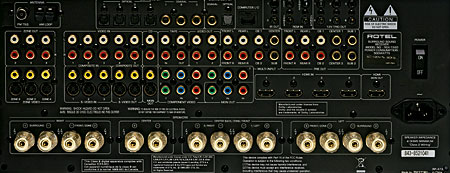What is the shelf life of "Top Pick" status on an item such as this? The review itself is not that old and the product is still current and yet it's specs seem borderline obsolete. Is the sound that good that it is in any way a better pick over the Marantz? Is the history of build quality with Rotel units so much better then Integra or other lower price competitors? And what of the Anthem receivers?
Rotel RSX-1560 A/V Receiver
 Price: $2,599 At A Glance: High-end implementation of Class D amplification • Among first Rotels with HDMI 1.3, lossless surround decoding • Faroudja video processing but no auto setup
Price: $2,599 At A Glance: High-end implementation of Class D amplification • Among first Rotels with HDMI 1.3, lossless surround decoding • Faroudja video processing but no auto setup
It’s Not Easy Being Green
Energy will likely be the defining challenge of our lifetimes. We use a lot of it but need to use less, so the ways in which we use it must become more responsible, creative, and resourceful. Will home theater continue to add to the quality of life in an energy-scarce future by bringing us closer to music and movies? Or will we write it off as just another accessory of sprawl, soon to be ruthlessly un-supersized? Is it possible to enjoy big pictures that are accompanied by big sound, while using less energy? This is the stage onto which the Rotel RSX-1560 A/V receiver walks, before an audience that is holding its breath.

Forget easy solutions, like swapping surround for stereo. With all other things being equal, five to seven channels use more power than two. But in real life, all things are rarely equal. A surround speaker package with a high efficiency rating, fed by an energy-saving Class D receiver, may use far less power than one of those two-channel dinosaur systems you see at audiophile trade shows, with doghouse-sized Class A monoblocks feeding a pair of speakers that were kidnapped from Stonehenge. The elevated temperature that drives you out of the room, diffused with the funk of lonely-guy audiophile sweat, tells you exactly how much power such a system wastes in the form of heat, as opposed to generating music. In energy efficiency, audio for home theater already occupies the high ground. As energy supplies peak and dwindle, this would be a good time to stake out even higher ground.
What right do I have to lecture you? Believe me, I’m no puritan. One of the various audio systems that’s strewn throughout my home uses a 6-watt-per-channel Class T amp. That’s a cousin of Class D, but it’s my rarely used kitchen system. I upgraded all my most oft-used lamps with compact fluorescents, but only after they became available in a variety of color temperatures (I prefer 4100K). I also swapped out my old PC for an ENERGY STAR model that uses a quarter of the power, but I simultaneously upgraded my monitor from 17 to 24 inches. I use air conditioning for fewer than 30 days (and three nights) per year, and only in one room at a time. However, when I need it, I crank it up gratefully, even if the local grid is burning up. I live in a small space in a big city and get around on trains, buses, and shoe rubber, but I still end every year with the ultimate carbon indulgence, a trip to Europe. So I’m not exactly a model citizen. I consider the possibilities, but I don’t spring for all of them at once.
Enter the RSX-1560. Yes, it is a Class D receiver, which uses a switch-mode power supply to efficiently feed high-current output devices. At $2,599, this receiver offers an opportunity to make a substantial investment in the future of home theater.
For me, this review was especially interesting, since the RSX-1560 is the direct replacement for a model line I revere, which includes the RSX-1067 and the RSX-1065. I’ve used the latter as my reference receiver since I reviewed it in 2001.
1.3 for Me, Please
The RSX-1560 and its little sister, the RSX-1550, are the first Rotel receivers to enter the HDMI 1.3 and lossless surround eras. Each has onboard decoding for Dolby TrueHD and DTS-HD Master Audio, as well as Dolby Digital Plus and DTS-HD High Resolution Audio. (However, they are not Rotel’s first HDMI receivers. That distinction belonged to the RSX-1057 and RSX-1058, which used HDMI 1.1 and have no lossless surround decoding.)

Both new models are available in either a matte black or bright brushed-aluminum finish, which Rotel, following industry custom, calls silver. The front panel has a rigorously symmetrical control layout, with two groups of 16 buttons flanking a central volume knob. At the top right are two knobs for quick on-the-fly bass and treble corrections. This adds a pleasingly old-fashioned bit of functionality for finicky listeners who hate menus. At the top left is a power on/standby button that’s encircled by blue LED lighting bright enough to read by.
Rotel’s customary user interface has almost completely evaded innovation. The GUI continues to be as black and white as Casablanca. It persists in a Rotel idiosyncrasy: When you press the Menu button, a System Status screen comes up a pokey few seconds later. This shows the input, listening mode, active speakers, and other miscellaneous information. You then must press the Enter button to go into the main setup menu. There’s no one-button entry to the main menu.
- Log in or register to post comments































































